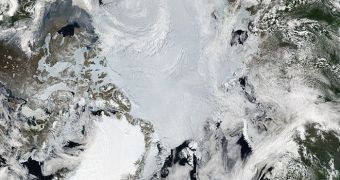According to the conclusions of a new scientific investigation, it would appear that Arctic sea ice decline is contributing to depleting the amounts of ozone present at ground level. The same phenomenon also contributes to promoting the release of more bromine in the air.
That is a very dangerous chemical that can lead to the deposition of increased amounts of toxic mercury at the North Pole. The study data cover the last decade, but experts believe that the readings may be indicative of an overall trend.
Chemists say that naturally-occurring interactions between very cold temperatures, sunlight and the salt in oceanic water are responsible for the release of bromine. The chemical is released when the three aforementioned factors mix in a particular way, something that has been happening increasingly often.
When bromine makes its way into the air, it triggers a cascade of reactions that chemists refer to as a bromine explosion. This promotes the development of bromine monoxide, a substance that readily interacts with gaseous mercury in the atmosphere.
The result is a pollutant form of mercury that then falls back to the ground. In addition, the chemical is also responsible for removing ozone from the troposphere, the lowest layer of the atmosphere. At this level, O3 is a pollutant, not a beneficial ally.
“Shrinking summer sea ice has drawn much attention to exploiting Arctic resources and improving maritime trading routes. But the change in sea ice composition also has impacts on the environment. Changing conditions in the Arctic might increase bromine explosions in the future,” says Son Nghiem.
The expert, who is based at the NASA Jet Propulsion Laboratory (JPL), in Pasadena, California, was the leader of the international collaboration that led the study. The group also included experts from the United Kingdom, Germany, the United States, and Canada.
Details of the investigation have been accepted for publication in an upcoming issue of the esteemed Journal of Geophysical Research- Atmospheres. A total of six satellites were used to collect the data on which the research was conducted.
These datasets were augmented with observations conducted in the field, as well as data from a computer model analyzing atmospheric movement patterns between the Beaufort Sea and the Canadian Arctic.

 14 DAY TRIAL //
14 DAY TRIAL //